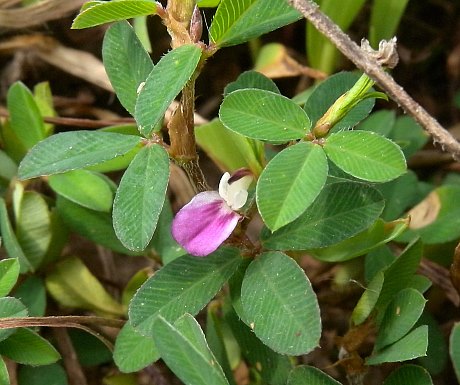
From the axils of the leaves, there develops 1-3 flowers on short pedicels about 1-3 mm. long. The orientation of the flowers varies from erect to lateral. Each flower is about ¼" (6 mm.) long, consisting of 5 petals, a short calyx with 5 teeth, and the reproductive organs. The petals are arranged in a pea-like floral structure, consisting of a banner, a curved keel, and a pair of wings. The banner is predominately pink or purple with several dark purple veins near its base, while the smaller wings are white. The keel is predominantly white, except along its outer edge, where it is blackish purple. The calyx is light green with ovate-oblong teeth. At the base of the calyx, there are 2 or more bractlets that are largely hidden by the flower. The blooming period occurs from mid-summer into fall, lasting about 1-2 months. In addition to the insect-pollinated flowers, sometimes inconspicuous flowers are produced that are self-fertile. The flowers are replaced by small seedpods about 4-5 mm. long. These seedpods are broadly ovoid and flattened in shape with a tapered base and short beak. Each mature seedpod contains a single dark seed that is ovoid and somewhat flattened. The 2-valved seedpods eventually split open to release their seeds. The root system consists of a shallow taproot. This wildflower reproduces by reseeding itself.
Range & Habitat: The non-native Japanese Bush Clover is fairly common in southern Illinois, occasional in central Illinois, and largely absent from the northern section of the state. This plant was introduced into North America from East Asia, where it is native, as a source of forage, hay, and a green manure to enrich the soil. It is still used for these agricultural purposes in southeastern United States. Habitats include pastures, cropland, fallow fields, roadsides, and sandy paths. Open areas with a history of disturbance provide preferred habitats for this species.
Faunal Associations: Because Kummerowia spp. (Annual Bush Clovers) are closely related to perennial Lespedeza spp. (Bush Clovers), they probably attract similar insects. The primary pollinators of the flowers are various bees, although small butterflies may visit the flowers for nectar to a lesser extent. Insects that feed destructively on the foliage and other parts of this group of plants include the caterpillars of various skippers (Hesperiidae), the leaf-mining larvae of some Buprestid beetles (Pachyschelus spp.), the caterpillars of Utetheisa bella (Bella Moth) and other moths, both adults and larvae of Colaspis brunnea (Grape Colaspis) and other leaf beetles, and the adults of Popillia japonica (Japanese Beetle). The seeds are eaten by some upland gamebirds and songbirds, including the Bobwhite Quail, Wild Turkey, Greater Prairie Chicken, Mourning Dove, Slate-Colored Junco, and White-Throated Sparrow. The Prairie Deer Mouse also eats the seeds. The foliage is grazed by White-Tailed Deer and many other mammalian herbivores.
Photographic Location: A sandy path at the Heron Boardwalk in Vermilion County, Illinois.
Comments: Sometimes Japanese Bush Clover is referred to as Lespedeza striata. This scientific name is considered obsolete. Another annual species that is found in Illinois, Kummerowia stipulacea (Korean Bush Clover), is very similar in appearance to Japanese Bush Clover and prefers similar habitats. Korean Bush Clover can be distinguished by the upward-pointing appressed hairs on its stems. In addition, the shape of its leaflets tends to be more broad (not less than one-half as much across as they are wide).